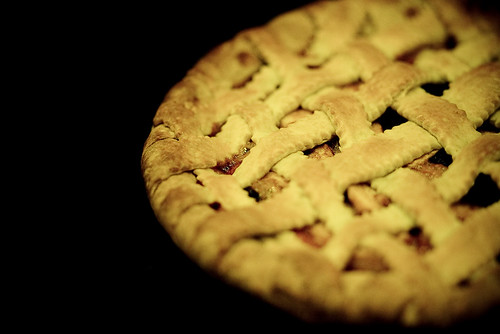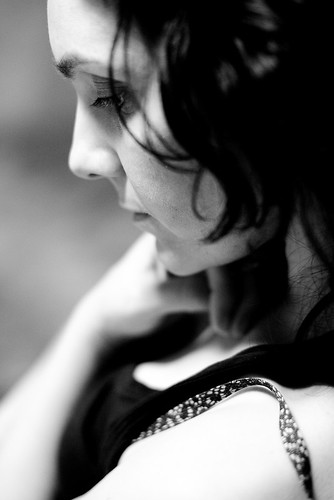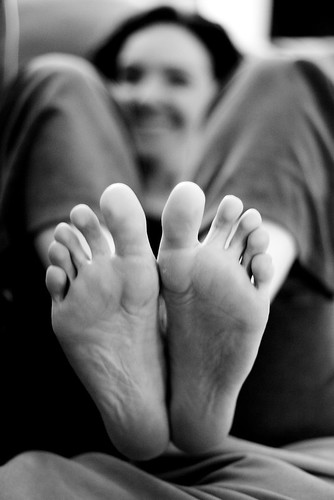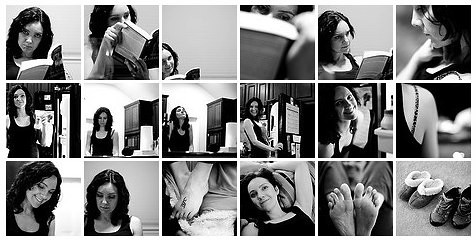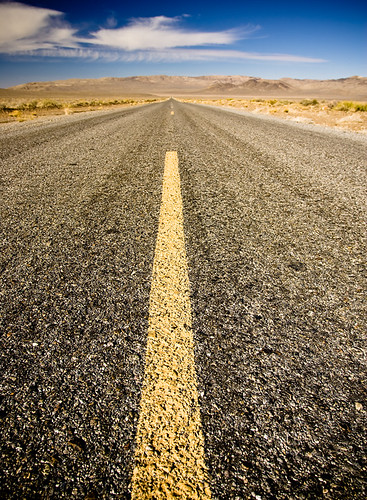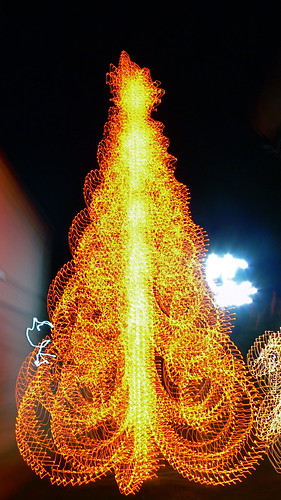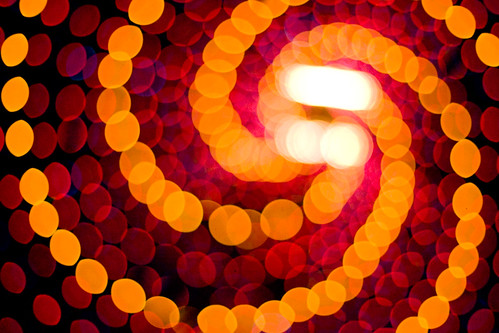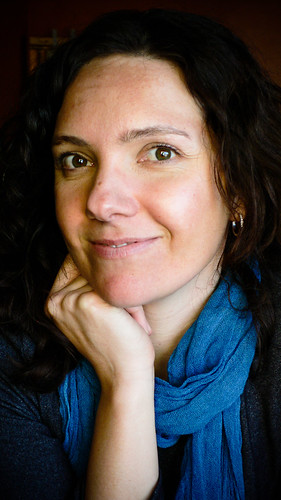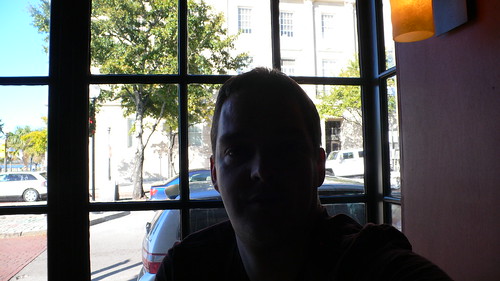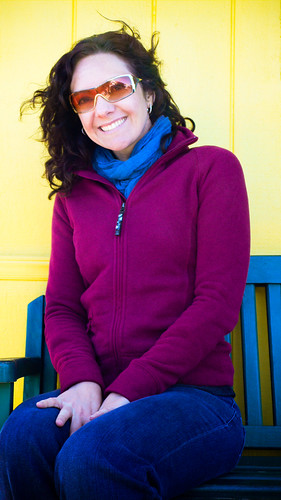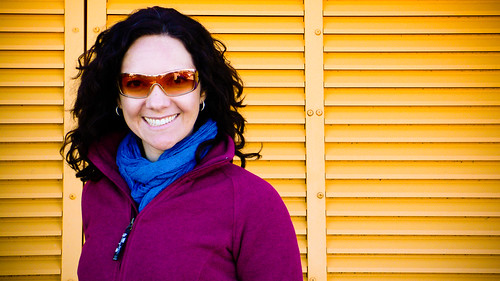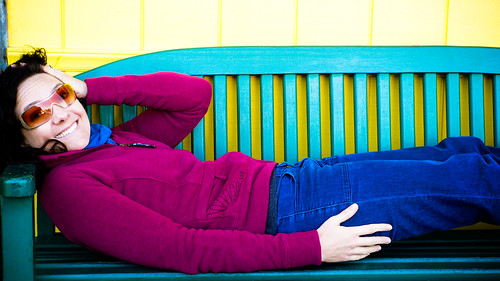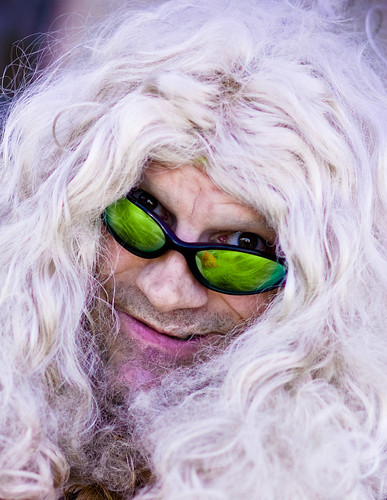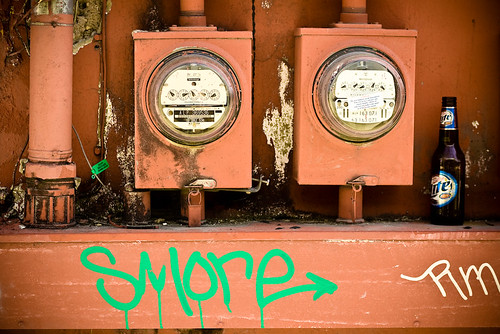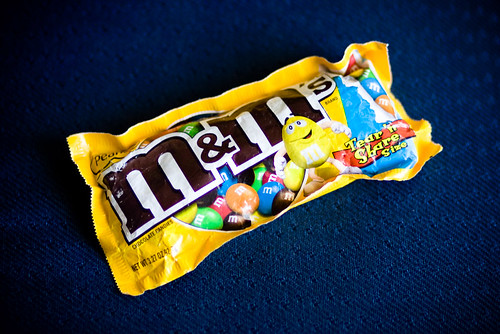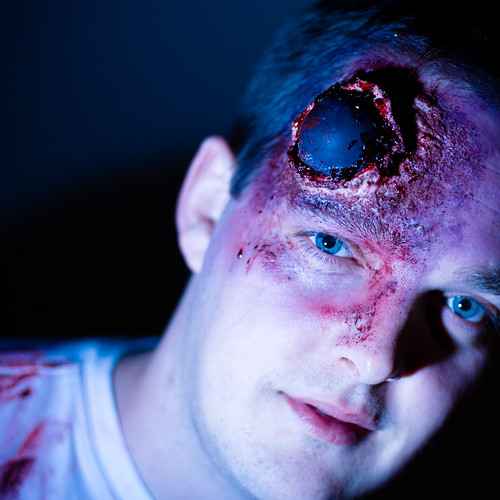Friday, November 28, 2008
Tuesday, November 25, 2008
@Home
I was already composing a post for today about how badly I failed at the reading deprivation. I struggled with it and failed miserably really. Kept reading blogs. Kept browsing the internet. But a funny thing happened while I was trying to avoid forums.
Last night, when I'd normally start reading a book or flicking through a magazine, I found some motivation to try again. Because I'd committed to at least attempting the Artist's Way exercise, I managed to spend time not reading. Instead I started working on the copy of my book that I'd printed out (yes I know, technically still reading, but I was writing too). Then along the way, I found an urge to pick up the camera and start taking some pictures. So I did. I took around 200 pictures of Amanda and I spending a quiet night at home, together. More pictures than I've taken for weeks. More fun than I've had in a while with a the camera, too. Maybe there is something in this exercise after all.
Posted by
Unknown
at
1:38 PM
3
comments
![]()
Labels: artists way, barriers
Monday, November 24, 2008
reading deprivation
I continue to stumble along trying to follow the Artist's Way program. This week, one of the big themes is reading deprivation. Avoiding any and all of the standard forms of reading that I do. The idea is that much of the things you read are just so many ways of avoiding hearing your inner thoughts and ideas. Words are little pieces of junk food that pollute the mind. Only about half a day into what is supposed to be a whole week of avoiding reading as much as possible. It is difficult! No blogs, no talk radio, no audio books, no magazines, forums, web pages, trying to limit email. Alone with your thoughts. TV isn't a valid substitute, so avoiding that too.
Interesting to realise how much of that sort of empty reading I normally consume in a week. In some ways I'm lucky this landed on Thanksgiving week - the long weekend holiday and plenty of other distractions to keep me occupied. Maybe I need to try this again later in a more typical week - but it is already quite a struggle. I think I'll pick up my camera, just for something to do (that's part of the idea after all!). Writing is a valid activity, so I may get around to doing some of the blog posts that have been backing up in my head. I suppose I should avoid reading any of the comments so don't expect a response this week.
ETA: After posting this blog entry, I then wandered over to google and searched for 'artists way reading deprivation' and read a few blogs about experience with trying to do this exercise. Not a great start...
Posted by
Unknown
at
12:55 PM
4
comments
![]()
Labels: artists way
Sunday, November 23, 2008
christmas is coming
Seems to be sooner and sooner every year. But then everyone complains about that, so I'll stop right there. I really like shooting Christmas lights. Meaningless, pointless and fun. I have a hard time standing still and shooting or using a tripod. I seem to always end up waving the camera around, or shooting out of focus or running back and forth while taking the pictures. Long exposures, out of focus, lensbabies, zooming the lens or my feet. So many fun ways to shoot Christmas lights in a non-literal way. Even with a small point and shoot camera, you can get good results, zooming with your feet while exposing, or twisting and turning the camera through the exposure, weaving trails of lights on the sensor.
Posted by
Unknown
at
1:11 PM
1 comments
![]()
Tuesday, November 18, 2008
end of the year already
Vanity Fair is already doing their 'year in review' photographs. I thought it was still just November. Good mix of imagery, mostly portraits and news.
Posted by
Unknown
at
9:39 PM
0
comments
![]()
Labels: portraits
easy questions about finding light
On this post, Mark asks a question:
How do you get Amanda exposed so nicely against such bright background colours? Or is it that there wasn't strong sunlight coming off the yellow background, so it didn't underexpose Amanda?
A good question without an easy answer. On the day, I put her in light that I thought would be good - didn't give it much thought at the time. That's an easy but mostly useless answer. Thinking about it more carefully, I put her in light that I knew would work well within the limits of the particular camera I was using. I was, as my friend Randy would say, in the pocket, shooting within the dynamic range that the camera can work with. I suppose I've learned where that is by taking a lot of bad pictures and looking at those results.
Maybe more usefully, these particular shots were taken on a bright, sunny day, but in open shade. The walls are in shadow, with the sun the other side of the buildings. Amanda and the walls are both facing away from the sun towards the open sky - bright day, lots of even light. Randy again describes the situation of finding light as going to where the light isn't, and looking the opposite direction. You find good light flooding in from there. Be in the shadows, and shoot with the subject facing the light.
One part of this is learning to see how your camera sees a scene - rather than how your eye sees. Sitting in a cafe, having lunch at the weekend Amanda & I were playing around taking pictures of ourselves. We were sitting up in the window of the cafe. Lots of light, a big window that faced the open sky, without any harsh sunlight. The window faced to the North (which is always a great window to use in the Northern hemisphere for portrait light). A generous woman at the next table offered to take our picture and we accepted her offer. Immediately she wanted to pose us with the window behind us, because 'the street outside was a more interesting background'. The only problem was the great light for portraits was coming in the window she wanted to put behind us. I suggested maybe we'd shoot it the other way around and she was happy to do it - maybe somewhat confused why I wanted to have the picture with the boring solid red wall of the cafe behind us. The same situation here - the light was outside, so we faced it. Also, the shot was taken with an appreciation of what the camera can do and how it sees light, rather than how our eye sees it. I snapped a quick shot of the alternative direction, just to show what it could have been like - bright, well exposed outside world, black silhouette of me. I could bias the camera to expose for me in the middle, but the window would be totally blown out. Shooting against the light (contra jour) can provide great results, but for portraits, I tend to like quite quiet, simple light. The other solution is to add light to the scene - with a flash or other light source, but the on camera flash is terrible on a small point and shoot and these are just quick snaps.
So the simple answer to Mark's question is have the subject stand in good light and orient them appropriately for the light source (the sky in both of these cases). Watching the background helps a lot too - keeping it cohesive with the subject - that doesn't necessarily mean bland or boring, but hopefully building on what you are trying to express, rather than fighting with it. Dealing with the direct sun is tough, so in both cases, I just avoided it - being in the shadow of the building in one, or using a North facing window in the other. Becoming sensitive to these sorts of things takes some careful attention to start noticing how shadows fall and where light is coming from. It also takes some experimentation to get familiar with how your camera sees a scene compared to your eye. All things that can be learned with a bit of focused practice.
I've got a part-finished sequence of images and comments that might give a bit more insight into how I try to find these sorts of locations with just ambient light and subject placement. Some day I want to go further with those examples. Maybe that's SoFoBoMo II or another book.
Posted by
Unknown
at
9:27 PM
3
comments
![]()
finding the time to be creative
I'm always struggling to find enough time in the day to be creative, around life, work and all those other commitments. I worry about trying to clear large enough chunks of time to go and photograph, or write or even to give proper consideration to a photography book or other reading. Reading and working through 'the artist's way ' one idea has stuck - just be creative in the time you have. It might just be 15 minutes but that's enough to keep things ticking over. You don't need to drag out the tripod and the serious camera. Just make some pictures. Yesterday's series of images of Amanda at the Kure Beach pier are a good example - we only shot for about 5 minutes, but it was fun and kicked off some new ideas in my head.
Posted by
Unknown
at
6:49 PM
1 comments
![]()
Labels: amanda, artists way, barriers, portraits, process, progress
Monday, November 17, 2008
a weekend at the beach
Only had a point and shoot pocket camera with me (little Panasonic DMC-LX1), but fun all the same. Certainly better than my cellphone.
Posted by
Unknown
at
8:11 AM
1 comments
![]()
Thursday, November 13, 2008
autumnal
Took a picture today. Was writing in my journal over lunch, rambling on about creative blocks and things like that. Got back in the car and was struck by the wet trees and colour. The picture is taken with a camera phone and isn't exactly my best ever, but it was surprising how compelled I was to make the image. I'm getting back to wanting to take pictures and I think the things I'm doing to try to spur on my creativity are actually starting to work, no matter how much I'm fighting against it.
I also got a chance to use FotoFlexer to edit the image. Surprisingly effective and easy to use. Good to use in a crunch.
Posted by
Unknown
at
9:32 PM
2
comments
![]()
Labels: colour
Wednesday, November 12, 2008
touching strangers

This is a fascinating project to me. Go take a look before you read any more. Trust me, it makes a difference.
Richard takes photographs of strangers, posed with other strangers to them and the photographer. The body language is strangely odd, more so even when you understand the relationship (or lack there of) between the subjects in each image. Joel Colberg has a great interview with Richard here, for Conscientious.
Having done a bit of street portraiture myself, I'm impressed by the courage shown to start this project. I wonder if the mystique of using a view camera helps to get the subjects involved, in this digital age. Great work.
Posted by
Unknown
at
9:56 PM
1 comments
![]()
Tuesday, November 11, 2008
good taste
When what you are doing just isn't as good as you aspire to be, you just have to keep working at it. Making radio shows, writing, taking pictures. Anything creative. You'll be doing it because you like it and have an idea what good is. You'll be a long way from that at first and for a long while to come. The only solution is to keep going - or quit.
Posted by
Unknown
at
11:12 PM
0
comments
![]()
Labels: creativity, process, progress
Monday, November 10, 2008
technical smechnical
Mark made a good comment on an earlier post:
It is so much simpler to compare and contrast feature sets between cameras or software. Or to discuss technical issues regarding any photograph. But it is always so much more difficult to discuss the less subjective measurements of photography and maybe that is why we gravitate to the objective ones.
This is demonstrably true. Many of the well known names in photography make their living teaching the technical aspects and mostly ignoring the more interesting but harder to express subjective aspects of creativity and photography. I've only found a few rare individuals interested in talking about the harder to grapple with concepts of the why of photography, rather than the how. Freeman Patterson always touches on this in his books. Craig Tanner often teaches this in person and occasionally in his podcasts. If you are aware of other good resources or teachers that focus less on the technical and explore the more subjective aspects of photography, I'd love to hear about them in the comments.
I think it is rare, not just because it is subjective, but because it is difficult. You have to be willing to expose yourself to harsh comments and opinions on things you actually care about. Few people care too much on a disagreement about sharpening techniques or how to adjust exposure. There are well worn and understood standard approaches to composition and basics of visual language that are mostly accepted and agreed upon. White balance and aperture priority are fixed concepts, not really open to much debate. But try to talk about what matters and people will explain to you in detail and at length why your world view is wrong and doesn't match theirs. It takes a certain personality to want to share and keep sharing in the face of that, even when the rewards might be so much greater, in actually connecting with people.
Posted by
Unknown
at
9:56 PM
1 comments
![]()
Labels: creativity, teaching
growth spurts
One doesn't see with one's eyes, one sees with the whole fruit of one's previous experience.
Anita describes a familiar lament over on her blog. She expresses dissatisfaction with the images she is currently taking, compared to those in her head. I've had long periods of feeling the way Anita does - my aspirations were well above my abilities. It has been a strange progression over the last 7 years.
Initially I loved so many of the pictures I took, fatally overlooking my lack of technical abilities that I had no understanding of. I was blind to the faults. I'd print them, share them, enter contests and juried shows and be bemused by rejection. After a while, I started producing passably good pictures - still technically flawed, but compositionally competent, satisfying and generally okay. I'd learned enough to see what was wrong with my earliest attempts. I could start seeing glaring flaws like over-sharpening halos and uncontrolled dynamic range. I have several prints around the house from this phase that I still like. They might now be in the laundry, but they are at least still on a visible wall.
Then I went through another growth spurt. I was back again to seeing the glaring flaws in all the pictures I was taking. I couldn't print anything out because by the time it came to printing or framing it, I already was dissappointed in the picture. I learned quite a bit about composition and technical printing in this phase. By the end of it, again quite a few, better, images adorn my walls. That was about 3 years ago.
The more you learn, the less you know
I guess I'm back in another satisfaction vacumm again. There are no photographs on the walls from the last 2 years. My standards might have shifted again, but also the subject matter I'm shooting has moved away from grand landscapes and other forms of easy wall decoration. The images are now lots of people I don't know or maybe more challenging but ultimately satisfying images that don't look so good on the wall. There are a few I've taken that I could think about printing, but even as I type and think about them, I can come up with all the reasons that I'd be dissatisfied with them. There's a book I suppose, but nothing else printed in the last couple of years.
The thing of it is, though, that these periods of dissastisfaction are really where the growth is occuring. If and when you think you are doing good work, then you no doubt are, but you aren't striving for something bigger. The dissappointment and continuing urge to get better shows you know what's wrong and what can be improved. When that moves to the background, and satisfaction sets in, then you've stopped being able to identify the areas for growth, at least for a while. Those plataeus are to be enjoyed, but the struggle up the mountain is where the improvement is really happening, even if you can't see it and want to just give up along the way.
I first encountered this concept of plateaus on the way to learning in the book Mastery: The Keys to Success and Long-Term Fulfillment A worthwhile read. I've also started using the Amazon affiliate program for links to books - feel free to buy through these links and I get a small amount back - or if it offends you, just type the name into your favourite book store and avoid my small attempts at commercialism.
True knowledge comes in knowing that you know nothing
- Socrates
ETA: Great comment from Paulo Bono on this post - well worth a read. It reminds me of the idea that a writer is someone who writes, and a photographer who is someone who takes photographs. If you aren't actually writing or taking the photographs, then you aren't really being a writer or a photographer or whatever sort of -er you aspire to be. Do the work and the rest will take care of itself.
Posted by
Unknown
at
9:33 PM
3
comments
![]()
Labels: barriers, editing, progress, thenextstep
productive creativity

Reading Ted Orland's The View From The Studio Doorjust now. Lots of thoughtful comments to wrap my mind around. For now I'm struck again by the need for productivity to be creative. Sitting around and thinking about great photographs doesn't make them happen. The muse doesn't strike unannounced when you aren't making pictures. A productive process is a necessary part of being creative. You've got to be making bad pictures or just making pictures to make the good pictures. Also, I'm starting to feel that over thinking the process or the pictures can be a great way to get you blocked from making any good images. The good ideas don't come from sitting, thinking about them in a vacuum. You have to be making the pictures you want to be making and part of finding what those images are is by finding them in the images you are already making. Yes, I've touched on these themes before, but it wasn't too surprising to find them again in this book.
So shoot a lot. Look at the work so far. Try to learn from it and then shoot a lot more seems to be one way forward.
Craig Tanner talks about sometimes needing to give himself permission to shoot at first. Firing off 20 or 30 random shots, just to get moving. It gets you past that feeling that every shot has to be worthwhile or meaningful and just lets you engage and get to work.
Posted by
Unknown
at
6:23 AM
1 comments
![]()
Sunday, November 09, 2008
frankenpuppets
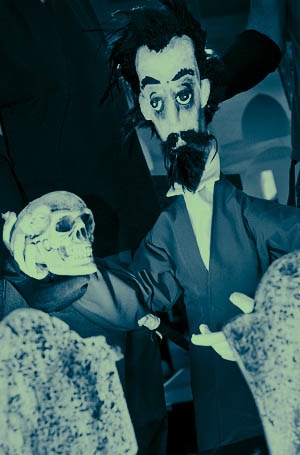
Amanda surprised me with a night out watching Frankenstein. The Trouble Puppet theatre make puppets from found objects, trash, anything they can get their hands on. The puppets are expressive, beautiful and dramatic, particularly given their origin. As a date I thought this was a particularly inspired idea - all day I thought we were going to the Dame Edna Experience but Amanda kept it secret. Overall I was happy to see the puppets! A small production in a strip mall in East Austin but such a magical evening. Haven't seen a puppet show for a long time - and those were always Punch and Judy seaside affairs. Things have moved on quite a bit since those days it seems, even though there was a traditional sock puppet up first to tell us to shut up and switch off our cell phones. A nice touch.
At first I was perhaps more interested in the mechanicals of how the puppets are animated. The puppeteers were on stage, dressed head to toe in black. There were a couple of people per puppet and it was usually obvious who was doing the voice acting too. Then, ever so subtly but very quickly, the puppeteers faded into the background and the puppets came to life. Just the same when I watch a great foreign language movie and realise that I'm not even noticing the sub-titles anymore, I was transported into the world of Frankenstein and the French revolution (they took some liberties with the original text)
So this is a photography blog and why am I twittering on about an albeit great date with my wife? The thing that struck me thinking back on this was I was initially caught up in the technical aspects of how the show was presented to me. But the strength of the story and imagery quickly distracted me from those technical issues. I didn't care that I could see that the sets were cardboard or not - I could easily enjoy what I was seeing without being worried about how it was presented. Great photography works the same way for me. I only care about the technical issues of sharpness, or lens resolution or tilted horizons and all those things people obsess about, when there's nothing interesting in the actual images. Technicals only really, really, critically matter when there isn't anything interesting in the image - at least for how I look at photographs. A little bit of blur, a little bit of softness - who cares; if the imagery is compelling.
Posted by
Unknown
at
2:46 PM
3
comments
![]()
Labels: geeky, inspiration, techy
Friday, November 07, 2008
crime & punishment in texas
Magnum in Motion: crime & punishment Dramatic mix of audio, video and still images. Powerful stuff.
Posted by
Unknown
at
10:45 PM
2
comments
![]()
Labels: editing, multimedia
Tuesday, November 04, 2008
Nanoo Nanoo

Good luck to anyone taking part in NaNoWriMo. Wil Wheaton has a long list of useful links relating to this.
Posted by
Unknown
at
12:28 PM
2
comments
![]()
Labels: books
Monday, November 03, 2008
first annual reader survey
Why do you read my blog?
What makes you come back, if you come back?
What sort of subjects are you more interested in?
What would you like to read more about?
Feel free to email me suggestions or leave feedback in the comments. I'm interested to hear what sort of things you've enjoyed in the past or what more you'd like to hear about in the future.
Featured comment
Pitchertaker asks "What I'm curious about is why would you ask such questions?"
In part this is motivated by Paul's post on the reasons to blog, which has had me thinking about what I'm doing here and why people might be interested in reading it or not. Secondly, it's because I'm going through a period of introspection and discovery, or at least trying to. I'm following the exercises in the Artist's Way, mostly motivated by the recommendations from Craig Tanner. I'm trying to decide how much of that, if any, to share, because a lot of it comes across as whiney, self-important complaining. Those who have looked at the Artist's Way might recognise that as my inner critic talking :) So far it has brought up some interesting ideas and thoughts, but I'm hesitant to share them, in part because I suspect they aren't robust enough to stand the slings and arrows of random blog commenters, but I'm trying to understand if that sort of thing is even interesting. Hope that in some way answers the question.
Posted by
Unknown
at
10:06 PM
15
comments
![]()
Labels: blogging
where do ideas come from II
Instructive podcast from Brooks Jensen on the need for single images. He talks about how project ideas tend to come from those single images. This has been something I've been rolling around in my head so it is timely to hear these thoughts from Brooks. (an interesting synchronicity right there and this is something I'll come back to in later posts)
So rather than trying to conceive project ideas in a vacuum or as an intellectual exercise, go shoot, shoot, shoot. Make those single images and follow the interest. At the same time, pay careful attention to any common themes or ideas that tickle your imagination. Then persue those threads of images and work hard to create related work. Turn the singular good images that spark your imagination into projects. Find the inspiration from the images you already make. This might be a more fruitful approach.
Posted by
Unknown
at
9:45 PM
3
comments
![]()
Labels: creativity, projects
where do your ideas come from?
I seem to over-think project ideas. Kill them before I even get around to starting them. Least that's my current theory about my lack of progress. I see in my mind's eye that the results wont be interesting enough, even before I start taking the pictures. I need to find a way to quiet those nagging doubts in my head that don't let me start. Well, I start, often enough, but the follow-through isn't there. Shorter projects work well because there isn't so much time for the dislike of the results to set in. I never feel the ideas are interesting enough, or worthwhile, or that anyone will care to look at them.
I've been journaling each morning for the last week, trying to find a way forward. That worked well in the past - I think I'm at the whining self-pitying phase at the moment. It'll pass.
Posted by
Unknown
at
7:47 AM
3
comments
![]()
Labels: creativity, projects, thenextstep
Saturday, November 01, 2008
halloween
A good chance to put what I've learned about off camera lighting to the test. Well, really a chance to take everything I've learned and try to do the opposite! Amanda did a fantastic job as the corpse bride. I had fun playing with make-up to give myself a big head wound, with a squash ball smack in the middle. Kate went for a classic vampire look. A lot of low angles with the flash and up close to get harsh shadows and quick fall-off. Was also a good time to use all those wacky coloured gels that you can't normally get away with using!
Posted by
Unknown
at
11:47 AM
2
comments
![]()
Labels: colour, creativity, lighting, portraits








